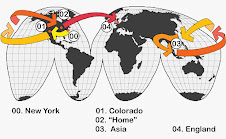Read the rest...
Le Corbusier divided the city into 1km sectors or neighborhoods, each with its own grocery store, worship places, school, etc. Set apart, the government buildings were the "head" of the city, while the city center, a pedestrian-only plaza and shopping block, was its "heart". I am amazed that a newly independant country, struggling with so many things including lack of funds was able to complete the project at all. The museum also included original complaint letters between architect and client, which, well, I found mildly amusing.
Do you see any garbage? Because I don't...
From the museum, we took a cycle rickshaw down one of the wide, tree-lined streets to the government buildings. We wandered through the High Court building (after a lengthy stop in a random office to get our camera approved):
(This swiss cheese concrete ramp was a nice feature of the building.)
(Does this look a little neglected to you?)
The city itself seems to be working quite well. Rents are some of the highest in India, and the city center was teaming with life- teenagers out parading, older couples walking, families out playing. But the buildings, well, all that concrete made them feel rather third-world. We aren't sure how else to put it! Perhaps it's the monsoon climate and the lack of money for upkeep, but they all looked rather "used", unfortunately. Still, we enjoyed the city because it really seemed to work.
One other place we visited was Nek Chand's Rock Garden. Nek Chand, a transport officer, created a small garden from rocks and odd peices of junk he found as hand that grew into a few acres of interlinked courtyards and impressive concrete creations. When the government found out about the illegal development, they decided to give Chand a salary and a crew to keep it going! It was absurd. Fun, but very, very strange!
(People made of bangle bracelets. Other materials included light sockets, cracked dishes, odd shaped stones...)
(This large courtyard was full of families, food vendors, a stage with two dancing teenagers and these pillars that looked like concrete cushions. Odd.)


2 comments:
Hi Meg,
I loved the picture of the bangle bracelet stautes. You know how I love bracelets. Did it say how many there were in one statue? I found the other structures quite unique. Thanks for putting Josh in a few pictures that are not showing the back of his head. He looks great. See you soon. Love forever and always, Mom
These pictures are so strange and extraordinary!
Post a Comment